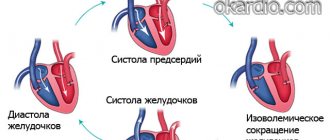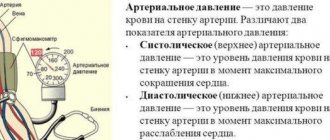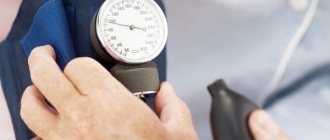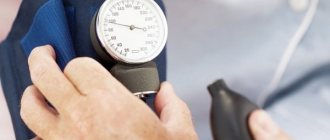The level of blood pressure (BP) in a person is determined by two indicators - upper and lower pressure. The top indicator is scientifically called systolic pressure, and the bottom is diastolic pressure. Together, both indicators show how correctly the heart muscle (myocardium) works, and its normal functioning depends on the work of the large arteries. They are a buffer that prevents the negative influence of external factors on human organs and systems.
After contraction of the cardiac sac, the arterial valve takes a closed position, due to which the flow of blood stops, and the flow of blood from the pulmonary artery, enriched with oxygen, begins. At the next beat, the process changes and blood moves throughout the body. The indicator that is responsible for normal blood flow is the lower, diastolic.
Pressure measurement procedure
Usually, a person’s systolic, upper, pressure increases, and the lower depends on it and jumps on its own in very rare cases. If its level is stably elevated simultaneously with the upper level or in isolation, essential hypertension is diagnosed. To determine whether a person’s circulatory and cardiovascular systems are functioning normally, one should also know about pulse pressure - this is the difference between the upper and lower limits of both indicators.
To determine blood pressure values, there is a special device - a tonometer. The devices are now sold as automatic, semi-automatic and manual, which are gradually going out of fashion as new affordable and improved models become available. The automatic tonometer independently determines to what level air needs to be pumped into the cuff to fully record the result.
But when using a hand-held device, you should adhere to a certain algorithm of actions:
- the cuff is fixed at a distance of 2–3 cm from the elbow, after which air intake begins using a rubber bulb;
- the size of the cuff should not be larger or smaller than the volume of the arm, it is better to choose the appropriate one for the correct measurement results;
- blood pressure is measured in a quiet environment, 30–40 minutes after the last meal;
- During the procedure, the person should not move, laugh or talk;
- the pressure gauge scale should be in front of the eyes, and the air should be pumped 30–40 mmHg higher than the expected systolic pressure;
- To record the readings as accurately as possible, measurements are taken on both hands twice, with an interval of 3–5 minutes.
No ads 1
After the measurements, the readings are deciphered if the procedure was performed correctly, taking into account the following points. The upper indicator (systolic) is recorded at the first audible pulse beat in the overstretched arm; it is the cardiac one. The systolic indicator indicates the force with which the heart pushes blood into the blood vessels. A person’s lower pressure is recorded when the heart muscle relaxes; it indicates the ability of the capillary walls to resist blood flow.
Pressure indicators depend on various factors - systolic characterizes the functioning of the myocardium, and diastolic depends on the functioning of the renal system (it is the kidneys that produce the hormone renin, which is responsible for the tone and elasticity of capillaries). The more elastic and durable a person’s blood vessels are, the more normal the diastole is.
Human blood pressure norms by age
Let's be honest, while we are young and healthy, we rarely worry about our blood pressure levels. We feel good and therefore there is no reason to worry. However, the human body ages and wears out. Unfortunately, this is a completely natural process from a physiological point of view, affecting not only the appearance of a person’s skin, but also all of his internal organs and systems, including blood pressure.
So, what should be the normal blood pressure in an adult and in children? How does age affect blood pressure? And at what age should you start monitoring this vital indicator?
To begin with, it should be noted that such an indicator as blood pressure actually depends on many individual factors (mental-emotional state of a person, time of day, taking certain medications, food or drinks, and so on).
Modern doctors are wary of all previously compiled tables with average blood pressure standards based on the patient’s age. The thing is that the latest research speaks in favor of an individual approach in each specific case. As a general rule, normal blood pressure in an adult of any age, no matter in men or women, should not exceed the threshold of 140/90 mm Hg. Art.
This means that if a person is 30 years old or at 50-60 years old the indicators are 130/80, then he does not have problems with the functioning of the heart. If the upper or systolic pressure exceeds 140/90 mm Hg, then the person is diagnosed with arterial hypertension . Drug treatment is carried out when the patient’s blood pressure “goes off scale” beyond 160/90 mm Hg.
When blood pressure is elevated, a person experiences the following symptoms:
- increased fatigue;
- noise in ears;
- swelling of the legs;
- dizziness;
- vision problems;
- decreased performance;
- nosebleed.
According to statistics, high upper blood pressure is most common in women, and low blood pressure is most common in older people of both sexes or in men. When the lower or diastolic blood pressure drops below 110/65 mm Hg, irreversible changes in internal organs and tissues occur, as blood supply deteriorates, and, consequently, oxygen saturation of the body.
If your blood pressure remains at 80 to 50 mm Hg, then you should immediately seek help from a specialist. Low lower blood pressure leads to oxygen starvation of the brain, which negatively affects the entire human body as a whole. This condition is as dangerous as high blood pressure. It is believed that the normal diastolic pressure of a person aged 60 years and older should not be more than 85-89 mmHg. Art.
Otherwise, hypotension or vegetative-vascular dystonia . With low blood pressure, symptoms such as:
- muscle weakness;
- headache;
- darkening of the eyes;
- dyspnea;
- lethargy;
- increased fatigue;
- photosensitivity , as well as discomfort from loud sounds;
- feeling of chills and coldness in the extremities.
Causes of low blood pressure may include:
- stressful situations;
- weather conditions, for example, stuffiness or sweltering heat;
- fatigue due to high loads;
- chronic lack of sleep;
- allergic reaction;
- certain medications, such as heart medications, pain medications, antibiotics , or antispasmodics .
However, there are examples where people live quietly throughout their lives with a lower blood pressure of 50 mmHg. Art. and, for example, former athletes whose heart muscles are hypertrophied due to constant physical activity feel great. That is why each individual person may have his own normal blood pressure readings, at which he feels great and lives a full life.
Causes of changes in blood pressure
High diastolic pressure indicates the presence of kidney, thyroid, or adrenal disease.
An increase in blood pressure can be caused by the following reasons:
- overweight;
- stress;
- atherosclerosis and some other diseases ;
- smoking and other bad habits;
- diabetes;
- unbalanced diet;
- sedentary lifestyle;
- weather changes.
Another important point regarding human blood pressure. To correctly determine all three indicators (upper, lower pressure and pulse), you need to follow simple measurement rules. Firstly, the optimal time to measure blood pressure is in the morning. Moreover, it is better to place the tonometer at the level of the heart, so the measurement will be the most accurate.
Secondly, the pressure may “jump” due to a sudden change in the person’s body posture. That is why you need to measure it after waking up, without getting out of bed. The arm with the tonometer cuff should be horizontal and motionless. Otherwise, the indicators produced by the device will have an error.
It is noteworthy that the difference between the indicators on both hands should not be more than 5 mm. The ideal situation is when the data does not differ depending on whether the pressure was measured on the right or left hand. If the indicators differ by 10 mm, then the risk of developing atherosclerosis , and a difference of 15-20 mm indicates abnormalities in the development of blood vessels or their stenosis .
What are the blood pressure standards for a person, table
Let us repeat once again that the table below with blood pressure norms by age is just reference material. Blood pressure is not a constant value and can fluctuate depending on many factors.
Pressure rate table:
| Age, years | Pressure (minimum value), mmHg. | Pressure (average), mmHg. | Pressure (maximum value), mmHg. |
| Up to a year | 75/50 | 90/60 | 100/75 |
| 1-5 | 80/55 | 95/65 | 110/79 |
| 6-13 | 90/60 | 105/70 | 115/80 |
| 14-19 | 105/73 | 117/77 | 120/81 |
| 20-24 | 108/75 | 120/79 | 132/83 |
| 25-29 | 109/76 | 121/80 | 133/84 |
| 30-34 | 110/77 | 122/81 | 134/85 |
| 35-39 | 111/78 | 123/82 | 135/86 |
| 40-44 | 112/79 | 125/83 | 137/87 |
| 45-49 | 115/80 | 127/84 | 139/88 |
| 50-54 | 116/81 | 129/85 | 142/89 |
| 55-59 | 118/82 | 131/86 | 144/90 |
| 60-64 | 121/83 | 134/87 | 147/91 |
In addition, in some categories of patients, for example, pregnant women , whose body, including the circulatory system, undergoes a number of changes during the period of bearing a child, the indicators may differ, and this will not be considered a dangerous deviation. However, as a guide, these blood pressure norms for adults can be useful for comparing your indicators with average numbers.
Table of blood pressure in children by age
Let's talk more about children's blood pressure. To begin with, it should be noted that in medicine, separate norms for blood pressure have been established for children from 0 to 10 years old and for adolescents, i.e. from 11 years and older. This is due, first of all, to the structure of the child’s heart at different ages, as well as to some changes in hormonal levels that occur during puberty.
It is important to emphasize that children’s blood pressure will be higher the older the child is; this is due to the greater elasticity of blood vessels in newborns and preschool children. However, with age, not only the elasticity of blood vessels changes, but also other parameters of the cardiovascular system, for example, the width of the lumen of veins and arteries, the area of the capillary network, and so on, which also affects blood pressure.
In addition, blood pressure indicators are influenced not only by the characteristics of the cardiovascular system (the structure and boundaries of the heart in children, the elasticity of blood vessels), but also by the presence of congenital developmental pathologies ( heart defects ) and the state of the nervous system.
Normal blood pressure for people of different ages:
| Age | Blood pressure (mm Hg) | |||
| Systolic | Diastolic | |||
| min | max | min | max | |
| Up to 2 weeks | 60 | 96 | 40 | 50 |
| 2-4 weeks | 80 | 112 | 40 | 74 |
| 2-12 months | 90 | 112 | 50 | 74 |
| 2-3 years | 100 | 112 | 60 | 74 |
| 3-5 years | 100 | 116 | 60 | 76 |
| 6-9 years | 100 | 122 | 60 | 78 |
| 10-12 years | 110 | 126 | 70 | 82 |
| 13-15 years old | 110 | 136 | 70 | 86 |
As can be seen from the table, the norm for newborn children (60-96 per 40-50 mmHg) is considered to be low blood pressure compared to older age. This is due to a dense network of capillaries and high vascular elasticity.
By the end of the first year of a child’s life, the indicators (90-112 by 50-74 mm Hg) increase noticeably, due to the development of the cardiovascular system (the tone of the vascular walls increases) and the whole organism as a whole. However, after a year, the growth of indicators slows down significantly and blood pressure is considered normal at a level of 100-112 at 60-74 mm Hg. These indicators gradually increase by 5 years to 100-116 by 60-76 mmHg.
Many parents of younger schoolchildren worry about what normal blood pressure is for a child aged 9 years and older. When a child goes to school, his life changes dramatically - there are more loads and responsibilities, and less free time. Therefore, the child’s body reacts differently to such a rapid change in usual life.
In principle, blood pressure indicators in children 6-9 years old differ slightly from the previous age period, only their maximum permissible limits expand (100-122 by 60-78 mm Hg). Pediatricians warn parents that at this age, children's blood pressure may deviate from the norm due to increased physical and psycho-emotional stress associated with entering school.
There is no reason to worry if the child is still feeling well. However, if you notice that your little schoolchild is too tired, often complains of headaches, is lethargic and in no mood, then this is a reason to be wary and check your blood pressure readings.
Normal blood pressure in a teenager
According to the table, blood pressure is normal in children 10-16 years old, if its levels do not exceed 110-136 per 70-86 mmHg. It is believed that at the age of 12 the so-called “transitional age” begins. Many parents are afraid of this period, since a child from an affectionate and obedient baby under the influence of hormones can turn into an emotionally unstable, touchy and rebellious teenager.
Unfortunately, this period is dangerous not only for sudden changes in mood, but also for the changes that occur in the child’s body. Hormones that are produced in larger quantities affect all vital human systems, including the cardiovascular system.
Therefore, pressure indicators during adolescence may deviate slightly from the above norms. The key word in this phrase is insignificant. This means that if a teenager feels unwell and has symptoms of high or low blood pressure, he needs to urgently contact a specialist who will examine the child and prescribe appropriate treatment.
A healthy body can adjust itself and prepare for adult life. At 13-15 years old, blood pressure will stop “jumping” and return to normal. However, in the presence of deviations and certain diseases, medical intervention and drug adjustment are required.
High blood pressure may be a symptom of:
- arterial hypertension (140/90 mmHg), which without appropriate treatment can lead to a severe hypertensive crisis ;
- symptomatic hypertension , which is characteristic of renal vascular diseases and adrenal tumors;
- vegetative-vascular dystonia , a disease characterized by surges in blood pressure within the range of 140/90 mmHg;
- lower blood pressure may increase due to pathologies in the kidneys ( stenosis , glomerulonephritis , atherosclerosis , developmental abnormalities );
- Upper blood pressure increases due to defects in the development of the cardiovascular system, diseases of the thyroid gland, and also in patients with anemia .
If blood pressure is low, there is a risk of developing:
- hypotension;
- myocardial infarction;
- vegetative-vascular dystonia;
- anemia;
- myocardiopathy;
- hypothyroidism;
- adrenal insufficiency;
- diseases of the hypothalamic-pituitary system.
Controlling your blood pressure levels is really very important, and not only at 40 or after fifty. A tonometer, like a thermometer, should be in the home medicine cabinet of everyone who wants to live a healthy and fulfilling life. Spending five minutes of your time on a simple procedure for measuring blood pressure is actually not difficult, and your body will thank you very much for it.
What does the change in indicators depend on?
The permissible minimum difference between the upper and lower values, as well as the normal blood pressure for people depending on age, will be described below. But the reasons for the jumps in these numbers can be various reasons. As a result of numerous studies, it has been proven that the standard of living, external factors and health status in general affect the results of blood pressure assessment.
If for one person an increase in indicators by 10–20 units is considered normal, then for another it can turn into a disaster.
In 90% of cases, overestimation of blood pressure is recorded in obese people, and age also affects blood pressure levels. In an elderly person, blood vessels lose their former elasticity, and the body as a whole and the cardiovascular system in particular undergo age-related changes - as a result, blood pressure increases. However, over the past decades, signs of persistent hypertension have also been observed in very young people aged 30–35 years.
No ads 2
The following factors influence this:
- nature of the diet;
- bad habits (smoking and alcohol abuse);
- lack of proper rest;
- excessive brain and physical activity, leading to exhaustion of the body;
- emotional overload and frequent stressful situations.
If the pressure is increased by 10–20 units after intense physical activity (sports, carrying heavy weights), this is absolutely normal and, after a while, the indicators will return to the initial values on their own. Blood pressure is usually reduced during sleep and immediately after waking up, since the body is in a state of rest and relaxation.
Completing all vital processes, before going to bed, the body also reacts with a jump in blood pressure by 10–20 units. Low blood pressure occurs in women during the menstrual cycle, during pregnancy, and in men during colds.
Why does the lower pressure change?
An increase in lower pressure may be associated with:
- Narrowing of the lumen in the renal arteries, their increased tone;
- Kidney diseases;
- Significant excess weight;
- Myocardial dysfunction;
- Diabetes mellitus;
- Changes in the concentration of hormones in the blood.
When diastolic pressure deviates from the norm, a person feels a loss of strength, chills in the lower extremities, and drowsiness. A nagging headache appears, sweating increases, concentration decreases and memory deteriorates. Possible discomfort in the heart area, arrhythmia. This is why it is important to measure your blood pressure regularly so that if there are any abnormalities, you can immediately consult a doctor.
Norm of upper and lower blood pressure
Constant fixation of indicators within 120/80 or 140/90 means that a person’s heart muscle and renal system are functioning correctly, and there is no reason to worry about health. In young people, indicators of 90/60 are considered normal, if the person feels well and does not complain of dizziness, weakness and weather sensitivity.
Weak pulse with high blood pressure
Also, indicators of upper and lower blood pressure are divided according to the norm depending on age groups:
- 16–20 years – normal values are 100/70, 120/80;
- 20–45 years – there is no reason to worry if the pressure is fixed at 120/70, 130/80;
- 50–60 years – normal blood pressure is 140/90;
- over 60 years old - blood pressure fluctuates within 150/90.
A gradual increase in blood pressure with age is the result of changes in the condition of the vascular walls, capillaries lose their former elasticity, and the heart muscle wears out. If you do not keep the aging process and natural wear and tear of the body under control, a disease may develop that affects all internal organs and systems and requires correction with medications - it is called hypertension.
The first degree of hypertension occurs with an increase in systolic pressure to 160 mm Hg, the second degree is diagnosed at the upper level of 180 mm Hg, and the third (dangerous to health and life) is characterized by surges in systolic blood pressure above 180 mm Hg.
At-risk groups
All elderly people are at risk of developing hypertension due to the natural aging of blood vessels and the heart. At an earlier age, the likelihood of high blood pressure is higher if:
- Diseases of the kidneys and blood vessels.
- Congenital heart defects.
- Obesity.
- Alcohol abuse, smoking.
- Frequent stress, disruption of work and rest schedules.
- Systematic intoxication with harmful substances.
- Eating foods high in cholesterol and salt.
- Diseases of the endocrine system.
People who have had head injuries or heart and brain surgery should also monitor their blood pressure.
Normal difference between systolic and diastolic pressure
The difference between the upper and lower blood pressure readings is called pulse pressure (PP), normally it is 40 units. A deviation in both directions of 5–10 units is allowed; this condition is not considered critical, therefore, if the normal PD is 30–50 units, there is no cause for concern. Both the physical and mental state of a person’s health can affect pulse pressure.
No ads 3
Insufficient nutrition, weather sensitivity, physical activity and emotional stress can temporarily reduce PD values, but when normal living conditions are restored, they return to normal on their own. A large, stable difference between systolic and diastolic pressure indicates pathologies developing in the body, the causes and etiology of which need to be clarified with the help of doctors.
A change in well-being will be noted when the PD deviates by more than 10 units in one direction or the other. For example, if a person has always recorded a difference between blood pressure readings of 50 units, then a drop in the norm to 30 units will already affect his condition, he may be talking about the emergence of health problems. Even if the pulse pressure remains within acceptable limits, it will still be considered low.
Symptoms of hypertension
Signs of pathology are the following conditions:
- Headache, often in the occipital region. May not respond to analgesics.
- Pulsation in the head, noise in the ears.
- Dizziness may occur with a sudden change in position.
- Decreased visual acuity, darkening of the eyes, sensation of “floaters”.
- Chills, increased sweating, rapid pulse, nausea.
- Nose bleed.
- Redness of the face and ears.
- Feelings of anxiety, restlessness, increased fatigue.
Symptoms may indicate more than just hypertension, but when one or more conditions appear, it is recommended to first measure blood pressure. If the values are higher than normal, consult a therapist or cardiologist.
Causes and symptoms of decreased heart pressure
The tonometer numbers decrease for various reasons. People whose heart pressure is below 110 units are called hypotensive. Some people have lower than normal heart pressure from birth, but are completely healthy.
All factors of low systolic blood pressure can be classified into physiological, psychological, and pathological. The first group includes the following negative factors:
- bad heredity;
- strict low-calorie diet, fasting;
- physical fatigue;
- bad habits;
- taking drugs that have a hypotensive effect.
Psychological reasons lie in worries and worries. It happens that the central nervous system cannot cope with stress. Nervous fatigue can lead to a decrease in tonometer numbers.
Pathological factors for a drop in heart pressure are represented by the following conditions:
- hypofunction of the thyroid gland;
- hypoxia;
- diseases of the central nervous system;
- abnormalities in the structure of the myocardium;
- vegetative-vascular imbalance of the hypotonic type;
- bleeding (external or internal);
- hormonal imbalances;
- disruption of the functioning of the endocrine glands;
- dehydration;
- stomach ulcer;
- anemia;
- infectious damage to the body;
- oncopathology.
You can suspect low heart pressure by the appearance of the following unpleasant symptoms:
- weakness;
- drowsiness;
- pallor of the epidermis;
- cold extremities;
- dizziness;
- pain in different parts of the head;
- impaired coordination of movements;
- abnormal heartbeat (bradycardia);
- sweating;
- loss of consciousness;
- deterioration in the quality of vision.
It must be taken into account that there is a concept of working blood pressure. It means those tonometer numbers at which a person has no unpleasant symptoms of hypotension or hypertension, and performance is at a high level.
Causes
It cannot be stated that the factors that cause upper blood pressure to reach critical levels have been thoroughly studied. There are different forms of the disease that directly affect the increase in blood pressure, as well as inadequate conditions of the nervous and metabolic systems, including ion tissue metabolism.
The upper pressure exceeds the norm due to the following factors:
1. Mental overstrain in 10-15%, stress, since adrenaline (stress hormone) has a strong effect on the heart. It begins to contract more often and emit more blood.
2. An increase in the ejection of blood by the heart per contraction at a high sodium concentration.
3. Spasms of smooth muscles that support the vascular walls and impaired regulation of blood pressure due to increased calcium levels.
4. Accumulation of atherosclerotic plaques on the vascular walls (20-25%), development of sclerosis. When the lumen of the arteries narrows, the heart increases its impulses to move blood, which increases blood pressure.
5. Active substances that are released by the kidneys when blood supply deteriorates. The substances contribute to a steady increase in pressure, including upper pressure.
6. Constant use of medications:
- oral contraceptives with large doses of hormones;
- medications that reduce appetite;
- glucocorticoids: Prednisolone, Dexamethasone;
- anti-inflammatory drugs: Indomethacin, etc.
7. Symptomatic hypertension, diabetes mellitus, dehydration.
8. Sedentary lifestyle and excess weight.
9. Hereditary factors.
10. Drinking alcohol and salty foods, smoking.











